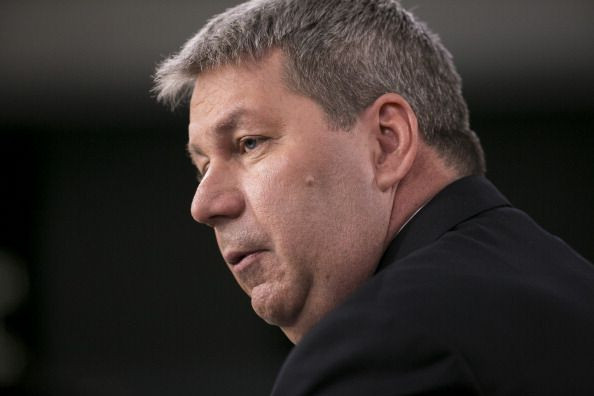Valeant’s Earnings Report: Three Big Surprises That Could Be Lurking In The Drugmaker’s Delayed Financials

Earnings season is over, but one major company has missed the boat: Valeant Pharmaceuticals International. The Canadian drugmaker is embroiled in an accounting firestorm that has only deepened with every attempt to put out the flames.
After months of weakness, Valeant’s share price tumbled more than 50 percent Tuesday as newly returned CEO J. Michael Pearson presented sharply reduced revenue projections on a call with investors. The scale of the fallout took some by surprise, particularly the Wall Street analysts who, with a few exceptions, recommended the stock throughout the upheaval.
“This one has been nothing short of humbling for me,” Evercore ISI analyst Umer Raffat said Wednesday, after suspending his buy rating and $200 price target on Valeant. “I clearly stand corrected.” Also humbled were major hedge fund investors such as Bill Ackman, who has been a staunch defender of the company, and John Paulson.
As Valeant prepares its delayed filings for 2015, it’s clear that what began as an internal investigation into revenue recognition at a single specialty pharmacy partner has ballooned into something larger — calling into question the company’s once-vaunted strategy of combining high-profile acquisitions with steep price hikes. Securities regulators launched an investigation of the firm last year.
Valeant’s 2015 financial report, which Pearson has said will “hopefully” come out in April, could contain even more unhappy surprises. Here are three investors should watch out for.
Specialty Pharmacies
Valeant’s woes began in October when a short-seller’s bombshell report compared the company to the now-defunct Enron and outlined how the firm was tied to a shadowy specialty pharmacy called Philidor Rx Services. As it turned out, Valeant maintained an arm’s-length relationship with the pharmacy, which it exited the same month the report was released.
In the aftermath, investors asked one big question: How much of Valeant’s growth relied on Philidor and similar arrangements? The answer has yet to come.
Specialty pharmacies manage patient orders and prescriptions, allowing drugmakers to sidestep retail outlets such as CVS and Walgreens for particular drugs, especially pricey medicines liable to be rejected by insurers in standard channels.
In the wake of the accusations around Philidor, Valeant assured investors that just 7 percent of its global revenue came from goods sold through the specialty pharmacy, which included dermatology products such as the $500-a-bottle foot cream Jublia. But what remains unclear is how much of the company’s once-skyrocketing growth depended on specialty channels that the firm has promised to leave behind.
Morgan Stanley analyst David Risinger has estimated that Philidor alone accounted for fully one-third of Valeant’s organic growth in the U.S. — that is, revenue increases based on higher sales as opposed to acquisitions.
As Pearson’s call with investors Tuesday made clear, the loss of Philidor has affected areas central to Valeant’s growth. Pearson singled out dermatology as likely to record a lower growth rate than in the past, “given the continued external pressure for managed care, the pricing environment and our slower-than-expected start in 2016.”
Translation: The price hikes that Valeant previously sent through its specialty pharmacy channels aren’t passing insurance industry muster anymore. When the drugmaker’s 2015 filings finally do come out, investors could be in for a rude awakening on this point.
Organic Growth
On Tuesday’s call, Valeant executives made clear it wasn’t just a few sales figures that might change after the financial review concluded. “Organic growth, business unit growth and price volume detail” would all be affected, Pearson said.
That warning gets at the most persistent of criticisms lobbed at Valeant’s business model: that the five-year acquisition spree that pushed the company’s stock price up sixfold also served to hide weaknesses in underlying sales growth. The firm spends the least on research and development (R&D) — just 3 percent of sales — in its peer group. Yet until recently Valeant projected higher sales growth than any of its rivals.
In a recent report, Wells Fargo analyst David Maris, one of the two Wall Street analysts to recommend ditching Valeant before its most recent collapse, questioned the wisdom of slashing budgets at newly acquired companies. “When Valeant buys a company and then cuts R&D, it reduces the value of some of those future products,” Maris wrote.
At root, investors are wondering whether Valeant’s growth in recent years has been more about increasing demand and sales, or more about acquiring companies by adding debt and jacking up drug prices.
There appears to be some disagreement between what executives have told investors and what they’ve told each other on that point. In April 2015, Pearson said “volume was greater than price in terms of our growth outside the United States” and that domestically “it’s shifting more to volume than price.”
But in documents released in connection with a congressional inquiry, an email showed former Chief Financial Officer Howard Schiller telling Pearson that 80 percent of growth was driven by price hikes, not sales volume.
The disparity between growth based on price hikes and growth based on sales volume was a key reason Allergan rejected a contentious takeover bid from Valeant in 2014. At the top of the list of drawbacks of such a combination, Allergan cited Valeant’s “anemic growth driven by what we believe are unsustainable price increases — not volume.”
Pearson called those claims “false and misleading.” However, Allergan’s executives likely have been feeling vindicated in recent months.
Murky Acquisitions
The recent turmoil at Valeant has prompted investors to re-examine the company’s acquisitions, fueled by cheap debt, which have included the eye care company Bausch & Lomb in 2013 and the gastrointestinal drugmaker Salix in 2015.
Of particular interest is the amount of goodwill associated with these acquisitions on Valeant’s balance sheet. Goodwill is an intangible asset that companies typically list after acquisitions, representing the difference between the acquired company’s tangible book value — the sum of its hard assets such as cash and facilities — and what the acquirer actually paid.
In the case of Salix, Valeant paid about $8 billion more than the company’s book value, booking the difference as goodwill.
Now, Valeant’s unusually large $17 billion mountain of goodwill has come under fresh scrutiny as investors ponder whether the company will be forced to notch down the reported value of its acquisitions. A sizable adjustment there could send a seismic shock throughout the firm’s balance sheet.
In the past, Valeant has apparently been reluctant to adjust its goodwill after big acquisitions. Companies are allowed one year following an acquisition to examine sales figures and determine whether the original goodwill estimate was accurate or should be reduced. Marking down that goodwill would take a bite out of earnings.
But Valeant has never reported such an impairment, MarketWatch reported. The company instead has employed an arcane reporting maneuver to avoid noticeable markdowns of its goodwill. By creatively reshuffling how it measures goodwill adjustments, the firm’s disclosures have been “quite opaque,” J. Edward Ketz, an associate professor of accounting at Pennsylvania State University’s Smeal College of Business, told MarketWatch.
A Valeant representative told MarketWatch the company “complies with the applicable accounting standards” regarding goodwill. But whether the firm meets investors’ standards may prove to be another matter.
© Copyright IBTimes 2025. All rights reserved.






















